Contamination of aquatic environment is increasing and has been associated with indiscriminate discharge of solid wastes and effluents generated from industrial, domestic and agricultural activities. These wastes and effluents contain harmful substances, such as metals, which constitute a major problem on the quality of the Nigerian coastal water. This study evaluated the impacts of heavy metals on the water and sediment quality of Ologe and Badagry Lagoons, South-West Nigeria. The heavy metals (Cr, Cd, Cu, Zn, Pb and Fe) in water and sediments was analyzed with atomic absorption spectrophotometer (AAS) using standard protocols. The pollution index (PI) indicated that Cd and Pb had significant effects on the water quality of Ologe and Badagry Lagoons. The metal indices (MI) with Cd, Pb and Zn exceeded the threshold level of (MI > 1). The enrichment factor (EF) indicated extremely contamination with Cd and Pb; significantly contamination with Cr and Cu and very highly contamination with Zn in the sediment of Ologe Lagoon (OL), while the EF in the sediment at Badagry Lagoon (BL) revealed significant enrichment. EF values decreased in order: Cd > Pb > Zn > Cr > Cu in Ologe Lagoon and Zn > Pb > Cr > Cu > Cd in Badagry Lagoon. The sediment pollution index (SPI) values of 174.6 in OL and 57.98 in BL that exceeds 20 are classified as toxic. The geo-accumulation index (Igeo) values for all metals fall in class 0 indicating no pollution, except for Cd that falls within class 1 exhibiting unpolluted to moderate pollution in Ologe lagoon. The calculated mean Effect Range Median quotient (m- ERM-Q) and mean Probable Effect Level quotient (m- PEL-Q) indicated that all metals discharged in the sediment of Ologe and Badagry Lagoons have a 12% and 25% probability of being toxic, respectively. The potential ecological risk factor of heavy metals in the sediment exhibited low ecological risk, except for Cd that indicated moderate ecological risk in Ologe and Badagry Lagoons. These levels of contaminations of the water and sediment with heavy metal beacons for intense strategic biomonitoring due to health concern, as local inhabitants use these lagoons for various economics purposes such as fishing, crop irrigation, dredging, discharge source for industrial effluents and other domestic activities.
Heavy metals, Lagoons, Ecological risk assessment, Pollution
There is unprecedented increase in the pollution status of most aquatic ecological systems by inorganic and organic compounds (polycyclic aromatic hydrocarbons (PAHs), polychlorinated biphenyls (PCBs) and heavy metals) across most countries of the world [1]. This poses adverse health impacts on both aquatic and terrestrial organisms. Among xenobiotics contaminating aquatic ecosystems, metals are ubiquitous and most persistent xenobiotics due to their non-biodegradability and bioaccumulation potentials in both biotic and abiotic (water and sediments) components of the ecosystems [2]. Moreover, they have multiple sources of entry into aquatic ecosystems. These sources have been broadly classified into natural (benthic agitation, flow changes, and natural erosion) and anthropogenic (effluent discharge and surface run-offs) sources [1,2]. Metals, when in aquatic environment, exhibit low solubility in surface waters but readily get adhered to water sediments and accumulate at the bottom of water body [3]. Therefore, assessment of metal concentrations in sediments plays important role in monitoring pollution status of aquatic ecosystems [1]. Metal concentration assessment in sediments was preferred as indicator of ecological risks assessment associated with aquatic ecosystem pollution [4]. Metals that adhered to sediments may be re-suspended to cause secondary contamination of the water environment. Therefore, sediments act as both sink and source of metals in the aquatic ecosystem [4]. Metals from sediments readily bioaccumulate and biomagnify in food chains via fish consumption (major route), although other aquatic vertebrates and invertebrates may also act as route of human exposure [5].
Estimation of metal concentrations in water, sediments and aquatic organisms may depict the past as well as the current trend of pollution status of an aquatic ecosystem. Hence, the determination of metal concentrations as index of sediment pollution status and the estimation of potential ecological risk to an aquatic ecosystem requires the use of several ecological assessment tools [6]. While Cd was the lowest with 0.67These tools are used to assess the toxic response factor for a given metal and thus can be used to evaluate the combined pollution risk during exposure, as well as geo-accumulation index, mean probable effect level (PEL) and effect range medium (ERM) quotient. Metal index of pollution analysis has been widely applied as indicators of water quality determination for seawater [7], River water [8,9], and drinking water [10,11].
Ologe Lagoon and Badagry Lagoons are among the nine continuous Lagoon systems found along the coast of Nigeria. The Ologe Lagoon, a freshwater system transverses Lagos and Ogun States in South-western Nigeria [12]. Based on the peculiarity of its location, Ologe Lagoon receives untreated industrial and domestic wastes from Agbara industrial estate in Ogun State. Although, the managements of the industries claim to operate an integrated waste treatment system before discharging the wastewater into the Lagoon via Owo River [13]. Despites this claim, studies have shown that metals, pesticide and fertilizer residues are highly concentrated in the water and sediments of the Ologe and Badagry Lagoons [14-18]. There is paucity of information associating the metal levels in the sediments with ecological risks in the two Lagoon. Moreover, no recent information on the metal status of the Lagoons in the last decade despites increase in anthropogenic activities around the Lagoons. Protection of water and aquatic ecosystem from adverse effects of pollutants, including metals, is central to environmental risk assessment [19]. Thus, the routine monitoring of heavy metals in aquatic environment is absolutely necessary for the assessment of health status of the ecosystems. Indiscriminate discharge of industrial effluent into water bodies is an increasing phenomenon in most Nigerian coastal water, and demands that these water bodies are routinely monitored to avoid an outbreak of adverse health effects on human and aquatic health.
The United State National Oceanic Atmospheric Administration (USNOAA) has developed Sediment Quality Guidelines (SQGs) for the assessment of contaminants in sediments using chemical and biological effect databases [20]. The chemical concentrations corresponding to the 10th and 50th percentiles of adverse biological effects are called the Effects-Range-Low (ERL) and Effects-Range-Medium (ERM) guidelines, respectively [21]. Another sediment quality guideline which is most widely used to assess the ecotoxicology of sediments is the Threshold Effect Level (TEL) and Probable Effect Level (PEL) approach. These approaches are based on the relation between measured concentrations of metals and observed biological effects, such as mortality, growth or reproduction of living organisms. While TEL refers to the concentration below which adverse effects are expected to occur only rarely, PEL indicates the concentration above which adverse effects are expected to occur frequently [22]. These guidelines along with heavy metal determination in sediments were employed to assess the impact of industrial and domestic activities on the water and sediment qualities of Ologe and Badagry Lagoons in highly industrialized part of South-Western Nigeria.
The study areas, Ologe and Badagry Lagoons, are part of the Lagos Lagoon complex within the southwestern region of Nigeria (Figure 1). Ologe Lagoon is a freshwater body which opens into the Atlantic Ocean via the Badagry creeks and the Lagos harbor. It lies between Longitudes 3°0' and 3°06' E and Latitudes 6°20' and 6°30' N. Similarly, Badagry Lagoon is part of a continuous system of Lagoons and Creeks along the coast of Nigeria forming border with the Republic of Benin and the Niger Delta. It is approximately 60 km long and 3 km wide and lies between Longitudes 3°0' and 3°45' E and Latitudes 6°25' and 6°30' N. These Lagoons serve several socio-economic needs (aquaculture, fishing, sand dredging and drainage) to the towns and villages around their borders [16]. However, they also serve as recipients of industrial effluents from most industrial and human activities within their vicinity.
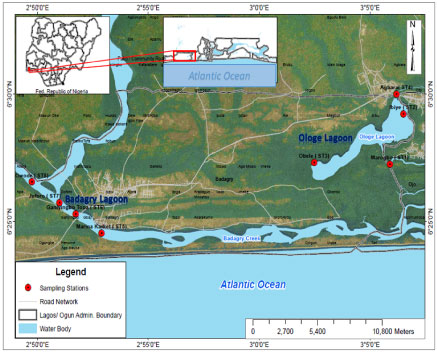 Figure 1: Map showing the selected sampling stations at Ologe and Badagry Lagoons.
View Figure 1
Figure 1: Map showing the selected sampling stations at Ologe and Badagry Lagoons.
View Figure 1
Water and sediments samples were collected monthly from four (4) selected stations in each of the Ologe and Badagry Lagoons (Figure 1) between October 2013 and April 2015. During sampling, water samples were collected in to a 1 L transparent plastic container, acidified with 2 drops of 68% concentrated HNO3 [23] and stored at 4 ℃ prior to metal analysis within the same week of sample collection. Also sediments were collected using a Van veen grab into transparent polyethene in chilled ice box and transported to the Marine Biology Department for metal analysis.
The following metals; Cr, Cd, Cu, Fe, Zn and Pb were selected for analysis due to their ecological relevance [24]. 100 mL of the water sample was added into a pre-cleaned beaker and 0.5 mL of 68% HNO3 and 5 mL of 35% HCl were added and the mixture heated to 95 ℃ for digestion process.
Following the metal digestion, the volume was made up to 10 mL with 0.1 N of 68% HNO3. The collected sediment samples were air dried, ground into fine powder using pestle and mortar, and sieved using 1 mm (pore size). 2 g of the dried sediment was taken in a digestion beaker and 10 mL of mixture of 35% HCl and 68% HNO3 in the ratio 3:1 was added and then digested at 95 ℃ for 2 h. The metal concentrations of both the digested water and sediment samples were quantified using GBC (Savant AA Sigma) flame atomic absorption spectrometer (AAS). All chemical regents used herein were of analytical reagent grade (Merck, United State). The glassware was pre-cleaned with nitric acid and rinsed with double distilled water.
Two metal pollution quality indices; Metal Index (MI) and Pollution Index (PI) were employed to determine the heavy metals pollution status of Ologe and Badagry lagoons.
Metal Index is the method of rating that shows the composite influence of individual parameter on the overall quality of water [25], and is calculated from the formula:
Where is the concentration of each analyzed metal (i), and MAC is the maximum allowable concentration of the metal, which was derived based on trend of the metal current status in accordance with Tamasi and Cini [25]. The higher the concentration of a metal compared to its respective MAC value, the worse the quality of the water. The metal index rated between 0 - 1, reflects the relative importance of individual metal quality considered and when metal index value is > 1, it signifies threshold of warning [26].
The pollution index (PI) of individual metal is calculated in accordance with Caerio, et al. [27] method from the equation:
Where = The concentration of each analyzed metal (i); = metal concentration according to standard water quality criteria permissible limits [28]. The value of PI derived from the equation is categorized from no effect to serious effects according to Varol [29] (Table 1).
Table 1: Categorization of water pollution index (PI). View Table 1
Heavy metals in sediments of Ologe and Badagry Lagoons originate from either natural or anthropogenic sources. To evaluate the anthropogenic contribution of the metals, the enrichment factor (EF) was determined in accordance with Tam and Yao [30] method from the equation below.
Where is the concentration of each metal analyzed in the water and sediment samples and is the concentration of Iron used as normalizer in accordance with Tam and Yao [30].When EF value is lower than 2, it suggests that the analyzed metals originated entirely from natural processes. While when EF value is greater than 2, it suggests that the metal is of anthropogenic origin [31] (Table 2).
Table 2: Classification of water contamination based on enrichment factor indicesin accordance with Soliman [22]. View Table 2
The enrichment factor facilitates sediment classification based on the metal contamination, but it does not take into account individual metal toxicity. Hence, the need for the determination of Sediment Pollution Index (SPI). SPI can be determined from the ratio of a linear combination of EF to the sum of the individual weight of the analyzed metals. This can be derived from the equation below in accordance with Rubio, et al. [32].
Where M = Metal, = Normalized weight of each metal and EF = Enrichment factor of a given metal. A weight of 1 is assigned to Cr and Zn, 2 to Cu, 5 to Pb and 300 to Cd [33]. Sediments are classified as toxic when the SPI value exceeds 20 [33,34].
The Geo-Accumulation Index (Igeo) is estimated to determine the level of contamination of the sediments by the analyzed metals. This is done from the equation below in accordance with Varol [29].
Where C is the measured mass ratio (i) of the metal assessed in the sediment, and B is the background level (i) of the metal. The factor 1.5 was used to correct possible variations in the background values of a particular metal in the environment. Igeo of the analyzed heavy metals allowed the analysis of the single factor contamination index to evaluate the presence of each individual metal and its level of contamination in the study area (Table 3).
Table 3: Classification of Geo-accumulation index of the analyzed heavy metals in accordance with Delgado [44. View Table 3
Mean PEL (M-ERM-Q) and ERM Quotients (M-PEL-Q) are developed by NOAA (National Oceanic and Atmospheric Administration) [35]. They are methods used to determine the possible biological effects of combination of toxicants. The M-ERM-Q is calculated from the equation below in accordance with Caerio [27].
Where represent the concentration, and the guidelines values for the element i, and n is the number of analyzed metals. Mean quotients are considered as useful tools for reducing a large amount of contaminants into a single entity. By calculating mean quotient, it may be assumed that the adverse effects of the contaminants to aquatic organisms is caused by individual chemicals.
Potential ecological risk index method determined in accordance with Soliman, et al. [22], considered the characteristics of the examined metal in relation to their environmental behavior. It is an approach employed to evaluate heavy metal contamination from the perspective of sedimentology [22]. According to this method, the potential ecological risk coefficient of a single element and the potential ecological risk index RI of the multi-element can be computed via the equations:
Where is the pollution coefficient of a single element of "I"; is the measured level of sedimentary heavy metal; is the background level of sedimentary heavy metal; is the toxic response factor for the given element "I", which amounts to the toxic requirement and sensitivity requirement (Table 4).
Table 4: Reference values (mg/kg) and toxicity coefficients () of heavy metals in sediments. View Table 4
The relationships between heavy metal concentrations investigated in water and sediment of Ologe and Badagry lagoons were determined using Pearson correlation analysis (SPSS version 20 and PAST 3.18) [36]. Principal Component Analysis (PCA) was used for the scattered plot and cluster analysis to assess the correlation and similarities of the heavy metals as well as to identify the potential anthropogenic origins of the metals.
The spatial distribution of heavy metals in surface water and sediments of Ologe and Badagry Lagoons are shown in Table 1 and Table 2. Table 1 presents the analysis of heavy metal concentrations in the surface water revealed a wide variation across the seasons. Zinc, with the mean concentration values of 5.79 and 8.44 mg/L for dry and wet season respectively (Ologe Lagoon), and 2.22 and 3.42 mg/L for dry and wet season respectively (Badagry Lagoon), recorded the highest values for both seasons and Lagoons. While Cr with mean concentration values of 0.04 and 0.03 mg/L for dry and wet seasons respectively (Ologe Lagoon), and Cd with mean concentration values 0.01 and 0.02 mg/L for dry and wet seasons respectively (Badagry Lagoon), recorded the least values according to the described seasons and Lagoons. The seasonal mean concentrations of the analyzed heavy metals in surface water revealed Cr with 0.03 mg/L, Cd with 0.06 mg/L, Cu with 1.57 mg/L, Zn with 7.06 mg/L and Pb with 0.04 mg/L in Ologe lagoon, and Cr with 0.02 mg/L, Cd with 0.02 mg/L, Cu with 0.61 mg/L, Zn with 2.82 mg/L and Pb with 0.04 mg/L in Badagry Lagoon. The recorded mean concentrations for Cd, Zn and Pb in the Ologe and Badagry lagoons were higher than permissible guidelines from International regulatory limits (Cd - 0.005, Zn - 5.0 and Pb - 0.015 mg/L) [28,37]. Statistical analysis using student's t-test showed that these mean concentrations were significantly (P < 0.05) difference for the heavy metals except Pb Figure 2.
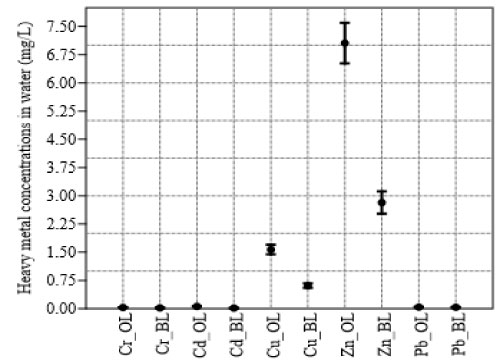 Figure 2: Mean concentrations of analyzed heavy metals in surface water. BL- Badagry Lagoon and OL- Ologe Lagoon.
View Figure 2
Figure 2: Mean concentrations of analyzed heavy metals in surface water. BL- Badagry Lagoon and OL- Ologe Lagoon.
View Figure 2
Figure 3 showed the result of the mass ratio of heavy metals in sediment recorded during the dry and wet season in the two sampled Lagoons. Similarly, Zn occurred with the highest value of 68.73 mg/kg (Ologe Lagoon) and 48.12 mg/kg (Badagry Lagoon) for both seasons. While Cd was the lowest with 0.67 mg/kg (Ologe Lagoon) and 0.07 mg/kg (Badagry Lagoon) for both seasons. The mean concentration of Cd in Ologe Lagoon was higher than the permissible guidelines from International regulatory limits (Cd - 0.60 mg/kg) [28]. Statistical analysis using Student's t-test showed that this was significantly (P < 0.05) high.
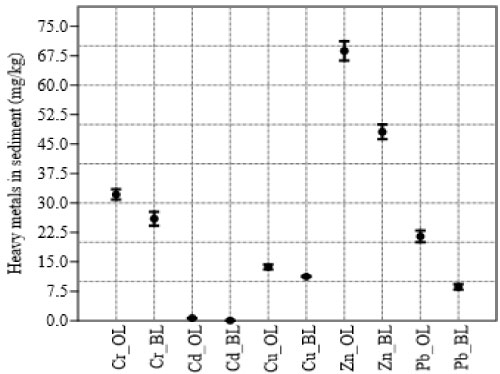 Figure 3: Mean concentrations of analyzed heavy metals in sediments (mg/kg). BL- Badagry Lagoon and OL- Ologe Lagoon.
View Figure 3
Figure 3: Mean concentrations of analyzed heavy metals in sediments (mg/kg). BL- Badagry Lagoon and OL- Ologe Lagoon.
View Figure 3
Table 5 presents a Pearson correlation coefficient matrix calculated for heavy metals in the sediments. There was strong positive correlation between Pb and Cr (r = 0.738*, P < 0.05), Pb and Zn (r = 0.745*, P < 0.05) in Badagry Lagoon and strong negative correlation between Cr and Cu (r = -0.775*, P < 0.05) in Badagry lagoon. This analysis which aimed to establish relationships and determine the common origin of the analyzed metals in the Ologe and Badagry lagoons, suggests that the metals accumulated from similar sources of pollution. The finding herein is in agreement with previous reports from other water bodies from different countries and it suggests that significant correlation between metals indicates redistribution in the sediments by similar physico-chemical processes and or they originate from a common source(s) [38,39].
Table 5: Pearson Correlation coefficient of heavy metals in sediment. View Table 5
Table 6 and Table 7 present the results of metal index and pollution load index respectively, of the Ologe and Badagry Lagoons. The metal index of the Lagoons showed that Cd, Zn and Pb are at the MI > 1 (threshold level), while Cr and Cu are at the MI < 1. These suggests that Cd, Zn and Pb constitute threat to the biotic communities in both Ologe and Badagry Lagoons, while Cr and Cu may pose no possible threat to the biotic communities. Also, the concentrations of Cd, Zn and Pb in the sampled Lagoons exceeded regulatory guideline limits. Therefore, it suggests that Ologe and Badagry Lagoon ecosystems are threatened by heavy metal pollution (most importantly Cd and Pb). Also that the concentrations of Cr and Cu are below threshold level (MI < 1) does not suggest that they cannot pose any form of threat. It is known that attrace concentrations, they readily accumulate in sediments and biologic tissues and may attain threshold levels [40]. Similarly, they can exhibit additive, synergistic and antagonistic interactive effects at their no observed effect concentration (NOEC) to induce adverse effects on aquatic biota and other tertiary consumers which can provoke serious public health issue [41,42].
Table 6: Metal index (MI) of surface water in Ologe and Badagry lagoons. View Table 6
Table 7: Sediment Pollution index (SPI) of the heavy metals in surface water of Ologe and Badagry lagoons. View Table 7
The result of the SPI of the analyzed heavy metals in the surface water showed that cadmium (Cd) and lead (Pb) had significant effects ranging from slight to serious effects on the water quality of Ologe and Badagry Lagoons. The SPI value suggests that Cd may have a serious effect on the water quality during both seasons in Ologe Lagoon, and may exact moderate and serious effects on the water quality during both seasons in Badagry Lagoon. Pb showed strong effect during the wet season and moderate effect during the dry season at Ologe Lagoon, and moderate effect during the wet season but serious effect during the dry season at the Badagry Lagoon. This suggests that the water qualities of the studied Lagoons may have been affected by the rate of atmospheric deposition, storm water runoff, domestic or industrial effluent or solid waste discharges that surpassed the carrying capacity of water [28,42,43].
Enrichment factor was calculated for all the sampling stations in the Lagoons to determine the sources of contamination. Table 8 presents the distribution average enrichment factor (EF) for both Lagoons. The results showed that sediments collected from Ologe Lagoon were extremely contaminated by Cd and Pb, significantly contaminated by Cr and Cu and very highly contaminated with Zn. While sediments collected from Badagry Lagoons howed that all the analyzed metals were significantly enriched in the sediments. The average EF values for the analyzed metals were in the order: Cd > Pb > Zn > Cr > Cu in sediments from Ologe Lagoon and Zn > Pb > Cr > Cu > Cd in sediments from Badagry Lagoon.
Table 8: Mean variation of heavy metals enrichment factors in sediment of Ologe and Badagry lagoons. View Table 8
The evaluation of SPI is based on the calculation of values obtained from enrichment factor. The sediment pollution index (SPI) was defined by Rubio, et al. [32] as a way of classifying the degree of pollution by metals in surface water and sediments. SPI values exceeded 20 in sediments from Ologe lagoon with SPI value of 174.6 and 57.98 in Badagry lagoon, therefore the sediments from these two lagoons are classified as toxic.
The Geo-accumulation index (Igeo) values were used to assess metal pollution in sediments of Ologe and Badagry lagoons. The Igeo is associated with a qualitative scale of pollution intensity, seven classes of pollution from unpolluted (Igeo ≤ 0) to extremely polluted (Igeo ≥ 5) are defined for the quality of sediments based on Igeo values [44,45]. The results of the Igeo value for all metals fall in class 0 indicating no pollution across all stations and seasons, except for Cd that falls within class 1 exhibiting unpolluted to moderate pollution in the sediment of Ologe lagoon as showed in Figure 4. On the basis of the Igeo classification, the metals were enriched and high in the sediments in the order; Cd > Pb > Zn > Cu > Cr in both lagoons.
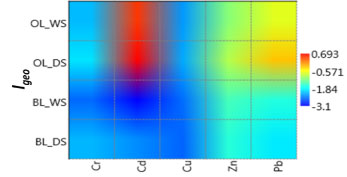 Figure 4: Plot matrix of the geo-accumulation index of heavy metals in sediment with varying gradient of pollution.
View Figure 4
Figure 4: Plot matrix of the geo-accumulation index of heavy metals in sediment with varying gradient of pollution.
View Figure 4
The m- ERM-Q calculated for the sampled sites (based on metals; Cr, Cd, Cu, Zn and Pb) which ranged from 0.08 to 0.09 (mean value of 0.09) in the wet season and 0.10 to 0.11 (mean value of 0.10) in the dry season of Ologe lagoon (Figure 5), indicated that the combination of Cr, Cd, Cu, Zn and Pb may have a 12% and 30% probability of being toxic during wet and dry seasons respectively. While, at Badagry lagoon, the m- ERM-Q calculated value of the metals ranged from 0.05 to 0.06 (mean value of 0.05) during both wet and dry seasons, indicating that the combination of Cr, Cd, Cu, Zn and Pb may have a 12% probability of being toxic. On the other hand, the mean value of m-PEL-Q in sediments of Ologe lagoon was determined to be 0.17 across all stations in the wet season and a range of 0.20 - 0.21 (mean value of 0.20) during the dry season, indicating that the combination of Cd, Cr, Cu, Ni, Pb and Zn may have a 25% probability of being toxic.
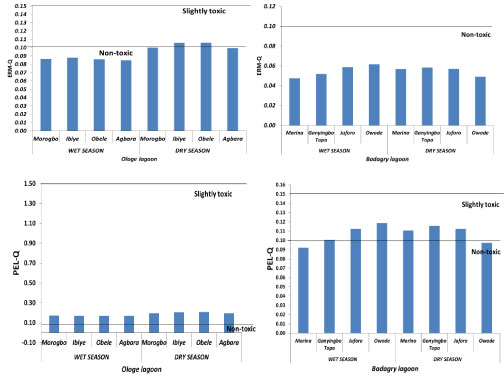 Figure 5: Estimated mean ERM-Q and mean PEL- Q of sediments from Ologe and Badagry lagoons.
View Figure 5
Figure 5: Estimated mean ERM-Q and mean PEL- Q of sediments from Ologe and Badagry lagoons.
View Figure 5
The estimated value for the potential ecological risk coefficient () and the potential ecological risk index (RI) are summarized in Table 9. The potential ecological risk factor of heavy metals in the sediment exhibited low ecological risk across all stations in Ologe and Badagry lagoons, except for Cd that showed moderate ecological risk in both wet and dry seasons. Coincidentally, the order of potential ecological risk coefficient () of heavy metals in sediments of both Ologe and Badagry lagoons followed the order; Cd > Pb > Cu > Cr > Zn. The potential ecological risk (RI) across the stations and seasons were below 150 indicating low ecological risk in both lagoons.
Table 9: Heavy metal potential ecological risk index of the Ologe lagoon and Badagry Lagoon. View Table 9
The multivariate analysis using Principal component analysis (PCA) and Cluster analysis (CA) has been proved to be an effective tool for providing suggestive information regarding heavy metal sources and pathways [46]. The results of the PCA obtained from total metal analysis of sediments from the study sites are presented in Table 9 and Figure 6a. Two main components with Eigenvalues greater than 1 were determined, explaining 81.49% of the cumulative variance. Apparently the result of PCA corresponds well with the correlation coefficients. The first component (PC1), with a variance of 56.96%, was highly correlated with Zn and Pb; correlation coefficients among this group of elements exceeded 0.7 (0.91 and 0.86). On the other hand, zinc and lead showed strong negative loading (-0.56 and -0.62) and copper with weak negative loading (-0.37). The second component (PC2) described 24.53% of the cumulative variance with significant loadings on Cu and Pb (0.73 and 0.81) and moderate positive loadings with Cr and Pb in Badagry lagoon (0.632 and 0.591), suggesting a similar source.
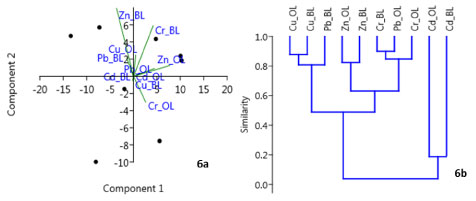 Figure 6: a) Scatter plot of heavy metals in sediment defined by PC1 and PC2; b) Dendrogram showing cluster of variables on the basis of similarity.
View Figure 6
Figure 6: a) Scatter plot of heavy metals in sediment defined by PC1 and PC2; b) Dendrogram showing cluster of variables on the basis of similarity.
View Figure 6
Cluster analysis is often used to complement PCA, to correlate findings and provide grouping of variables [46]. CA was performed to depict a dendrogram with paired group (UPGMA) and Bray-Curtis coefficient distance in Figure 6b. The cluster analysis results indicate three clusters: 1) Cu-Pb; 2) Zn-Cr-Pb; 3) Cd in terms of similarities. This is a clear indication that Zn, Cr and Pb must have originated from a specific source of discharge either from an industrial activities or natural sources. Cadmium displays none of strong correlations and distance between the other metals, indicating that Cd has originated from different pathways (Table 10).
Table 10: Factor loadings on elements in sediments from Ologe and Badagry lagoons (n = 16). View Table 10
Metals are common and have been well described as aquatic micro-pollutants. They constitute the oldest chemicals widely studied for their high level of deleterious effects on aquatic and terrestrial organisms including human beings [37,47,48]. Metal toxicity to animals and human is still highly relevant and will continue to increase due to natural and anthropogenic processes which generate and discharge wastes containing different metals into the environment [48]. Moreover, they persist in the environment and within tissues of organisms, due to their non-biodegradability that enhance bioaccumulation and biomagnification [49]. Biota in aquatic ecosystems come in contacts with these metals through water, sediments and or food sources and are daily exposed to individuals and or mixtures of these metals. Findings from the multivariate analysis using Principal component analysis (PCA) and Cluster analysis (CA) that the analyzed metals were from a specific source of origin is in tandem with the report of Ndimele, et al. [40] and Kumolu-Johnson, et al. [31] that the studied Lagoons received direct dumping of solid wastes and industrial effluents from the surrounding anthropogenic activities. The results from the enrichment factor that Ologe and Badagry sediments are enriched with the analyzed metals suggests the ability of these metals to accumulate in the sediments than the surface water [50]. This finding is in concert with the reports of Zhuang and Gao [42] that the sediments of Laizhou Bay and coastal waters of Zhangzi Island in China were enriched with metal pollutants and suggesting direct or indirect discharge of anthropogenic generated waste with metals into the aquatic environment. It also agrees with the Geo-accumulation index (Igeo) that Ologe lagoon is moderately polluted by Cd and Pb and Badagry Lagoon by Zn and Pb [50,51]. Although, the estimated value for the potential ecological risk coefficient () and the potential ecological risk index (RI) showed that the analyzed metals in the sediment exhibited low ecological risk across all stations in Ologe and Badagry lagoons, however, considering that metals rarely degrade but with high bioaccumulation potentials suggest deleterious impacts on aquatic biota. Some of the analyzed metals herein have been shown to bioaccumulate in Cynothrissamento [17] and Chrysichthys nigrodigitatus [52] collected from the studied Lagoons.
Health impacts of metal accumulation in resident biota from the studied Lagoons may include significant increase in genome instability and pathological lesions (Loss and disorganization of the primary and secondary lamellae, multifocal degeneration, hemorrhages, cellularinfiltration, congestions, vacuolations, atresia, and necrosis) in viscera including liver, kidney, gills and gonads and cancer development [53]. This suggests that metal exposure may be highly disturbing to the health status of the residence organisms which may lead to genetic related diseases, reproductive disorder and tumour formation [53].
Among the analyzed metals herein, Cd and Pb that were well enriched in the studied Lagoons do not have any known biochemical and physiological roles in biological system. Moreover, they are among the list of top prioritized hazardous sub-stances [54]. Moreover, they have been classified as probable human carcinogen (Group 2B) for Pb [55] and carcinogen (GroupA) for Cd [56]. It is also important to note that other analyzed metals, Zn, Cr and Cu though are essential nutrients that play vital roles in physiological processes of most aquatic species at trace concentrations. However when in access concentration due to bioaccumulation in tissues or environment, they are capable of disrupting via generation of dangerous free radicals that will disrupt the biological homeostasis of the aquatic forms leading to harmful health impacts [57,58]. More importantly current studies on metal toxicity are focusing on scientific importance of interactions among individuals of these metals in the cassation of pathophysiological disorder [41].
Human consumption of aquatic resources contaminated with metals (Pb and Cd) from an ecosystem have been associated with renal failure and chronic anaemia and well spread high mortality [5,59]. Also, Amadi, et al. [10] have shown that heavy metal toxicity can result in damaged or abnormal central nervous system functioning, lower energy levels, and damage to blood composition, lungs, kidneys, liver, and other vital organs especially when biomagnified in human. Thus, the heavy metals concentrates in Ologe and Badagry lagoons beacon for health concern as local inhabitants use the lagoons for various economics purposes such as fishing, crop irrigation, dredging, discharge source for industrial effluents and other domestic activities.